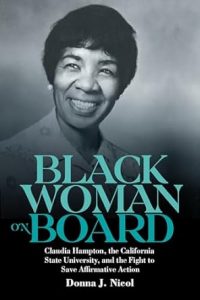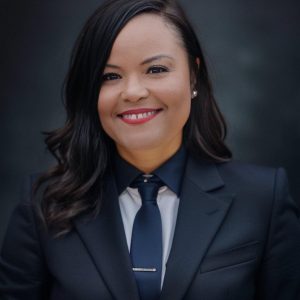Black Woman on Board: Claudia Hampton, the California State University, and the Fight to Save Affirmative Action
About: Black Woman on Board: Claudia Hampton, the California State University, and the Fight to Save Affirmative Action
 Offers a rare view inside the university boardroom, uncovering the vital role Black women educational leaders have played in ensuring access and equity for all. Black Woman on Board examines the leadership strategies that Black women educators have employed as influential power brokers in predominantly white colleges and universities in the United States.
Offers a rare view inside the university boardroom, uncovering the vital role Black women educational leaders have played in ensuring access and equity for all. Black Woman on Board examines the leadership strategies that Black women educators have employed as influential power brokers in predominantly white colleges and universities in the United States.
Author Donna J. Nicol tells the extraordinary story of Dr. Claudia H. Hampton, the California State University (CSU) system’s first Black woman trustee who later became the board’s first woman chair, and her twenty-year fight (1974–94) to increase access within the CSU for historically marginalized and underrepresented groups. Amid a growing white backlash against changes brought on by the 1960s Civil Rights and Black Power Movements, Nicol argues that Hampton enacted “sly civility” to persuade fellow trustees, CSU system officials, and state lawmakers to enforce federal and state affirmative action mandates.
Black Woman on Board explores how Hampton methodically “played the game of boardsmanship,” using the soft power she cultivated amongst her peers to remove barriers that might have impeded the implementation and expansion of affirmative action policies and programs. In illuminating the ways that Hampton transformed the CSU as the “affirmative action trustee,” this remarkable book makes an important contribution to the history of higher education and to the historiography of Black women’s educational leadership in the post-Civil Rights era.
Excerpt from Black Woman on Board: Claudia Hampton, the California State University, and the Fight to Save Affirmative Action:
Hampton strategically disarmed the threat posed by her race by playing to the gender norm using sly civility and respectability as resistance tools. In the early years of her appointment, Claudia Hampton used her charm and wits to influence her colleagues to side with her position when it came to selecting presidents or voting on resolutions because, for the first few years, Hampton was closed out of the “telephone network.” She says, “It was several years before I became part of the “telephone network”. For several years, three or four, I didn’t hear from anybody from July to September.” The telephone network was an informal system where trustees would discuss upcoming votes before board meetings using this informal time to “count votes” before the next meeting.
The telephone network utilized phone calls and in-person meetings to discuss board business outside of normal board meeting times. Since Hampton did not know anyone on the board prior to her appointment, she was not granted access to this network for several years and often had to make her case during board meetings which were so structured that it often difficult to discuss a particular issue at length. After observing the meeting structure and how her fellow trustees conducted themselves during meetings, she decided she needed to find a way to become more of a participant rather than a mere observer. “I daresay the first board meetings I went to I never opened my mouth. But eventually I said well I’m here for eight years, I must be here for a reason. Somebody thought I should be here. And I’ve gotta really get into this thing and participate.”
Hampton figured out quickly that she needed to trade votes to gain some favor with trustees with whom she often disagreed politically to gain access to the telephone network. For example, Charles Luckman, the trustee with whom Hampton traded chits to get the votes needed for Donald Gerth to become president of CSC Dominguez Hills, had considerable influence on the board. Gerth said, “Claudia was able to work with all these people” when speaking about Hampton’s relationships with powerful trustees like Luckman, governors, and chancellors.
Hampton’s success in convincing her fellow trustees that she was a political moderate, even though she vigorously championed affirmative action, helped her eventually gain access to this network, which was generally reserved for more experienced white male members of the board. After she was accepted into this informal network, Hampton’s influence and power on the board grew considerably. For example, Hampton could easily gain support for affirmative action because she had already discussed her position and was able to change someone’s mind during the telephone network process.
Once Hampton was accepted into the fold, the in-person ‘telephone network’ meetings often took place at Hampton’s home in Los Angeles where she became hostess, preparing a meal and entertaining a select group of trustees and campus presidents. Herb Carter says that days before hosting the telephone network meetings, he and Hampton would meet at her house to plan and strategize before she made dinner for her white trustee colleagues, “We’d sit there and drink wine. Smoke and drink. That’s how she kind of ran stuff in the board.” Hampton continued hosting the telephone network for several years after she appointed board chair. Donald Gerth recalls that sometime in the mid-1980s, “I can remember going to Claudia’s house. Well, I remember one time I brought about three or four presidents with Jim Cleary, Ellis McCune, and a couple of others to her house where we talked about settling some disputes when Ann Reynolds was chancellor.” Playing hostess was one sure-fire way that Hampton could participate as a full member of the network while playing to the gender norm of the day. Nothing in the historical record indicates that Hampton was asked to host these meetings by her white male peers. Instead, Hampton and other Black women like her, who had to work with white men to secure opportunities and resources for their communities, often volunteered and placed themselves in situations where they could influence their peers in a less formal work setting. As an example, Virna Canson recalls that on two separate occasions she and Claudia Hampton hosted parties in honor of Alex Sheriffs when he left the Reagan administration before joining the CSC Chancellor’s Office, “We had a party for Alex at my house. My husband cooked steaks and stuff. We just had a great time. There was a later party which Claudia gave. It was very interesting. There is a science to that.” Here Canson is referring to the science of informal social networking with someone for whom you might not have much in common with politically, but you can have a good time together socially. Herb Carter even recalled Hampton going out for beers and cigarettes with individual trustees after board meetings. This type of hosting and socializing gave Black women a unique opportunity to potentially develop lasting friendships with their white peers, which could help influence their votes on issues of importance to these women.
Thus, it was a stroke of genius for Hampton to engage in this sort of sly civility behavior because she could downplay the threat posed by her race, since she was not challenging the status quo regarding gender. Hampton was likely to have advanced much further in her role as trustee as a Black woman than if a Black man had served because her gender posed little to no threat to the majority white male board. Serving as a hostess in this regard allowed Hampton to play the long game of ‘boardsmanship’ because she could disarm some of the racial hostility she might have encountered, had she also presented herself as a staunch feminist.
BUY HERE
—
Dr. Donna J. Nicol
 Dr. Donna J. Nicol is the Associate Dean of Personnel and Curriculum in the College of Liberal Arts and a professor of history at California State University Long Beach. She is the immediate past department chair and professor of Africana Studies at CSU Dominguez Hills, a post she held from 2017-2023. She earned her doctorate degree in Educational Studies (with a specialization in History and Philosophy of Higher Education and a graduate minor in African American and African Studies) from The Ohio State University in 2007.
Dr. Donna J. Nicol is the Associate Dean of Personnel and Curriculum in the College of Liberal Arts and a professor of history at California State University Long Beach. She is the immediate past department chair and professor of Africana Studies at CSU Dominguez Hills, a post she held from 2017-2023. She earned her doctorate degree in Educational Studies (with a specialization in History and Philosophy of Higher Education and a graduate minor in African American and African Studies) from The Ohio State University in 2007.
Dr. Nicol’s research focuses on race, conservative philanthropy, and U.S. higher education, and the history of African American women’s educational activism. Her work has been published in Race, Ethnicity and Education, The Feminist Teacher (twice), History of Philanthropy, Palimpsest: A Journal of Women, Gender and the Black International, The Encyclopedia of American Women’s History, Encyclopedia of Multiracial America, and Habitus of the Hood. In February 2021, Dr. Nicol was a featured guest expert for the Al Jazeera English documentary, The Big Picture: A Race for America
Prior to becoming an academic, Dr. Nicol spent three years teaching secondary language arts and social studies for Los Angeles Unified School District and seven years in various academic administrative roles at Mt. St. Mary’s College and The Ohio State University. She serves on the board of directors for the Historical Society of Southern California, co-principal investigator for the State of Black Los Angeles County Report (2023) and is active in a number of professional academic and social service organizations.
Category: On Writing






























